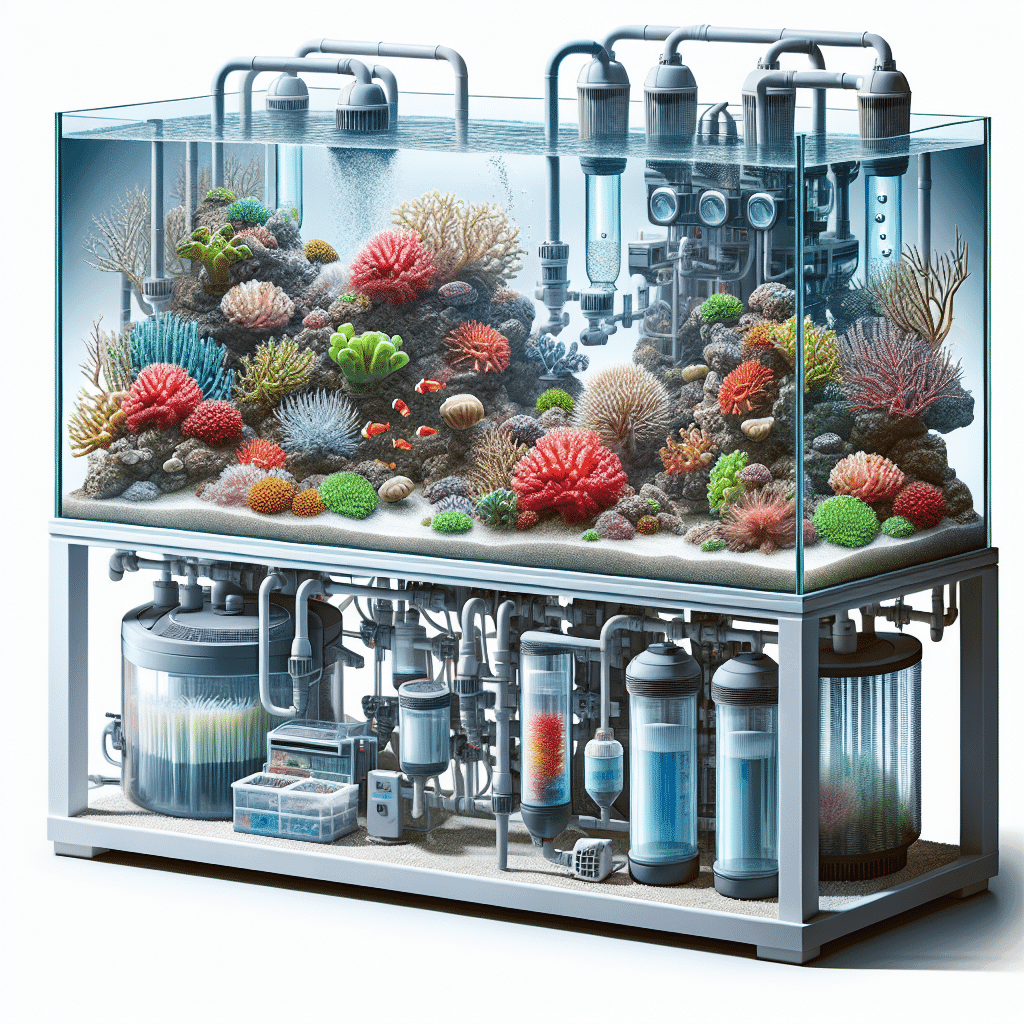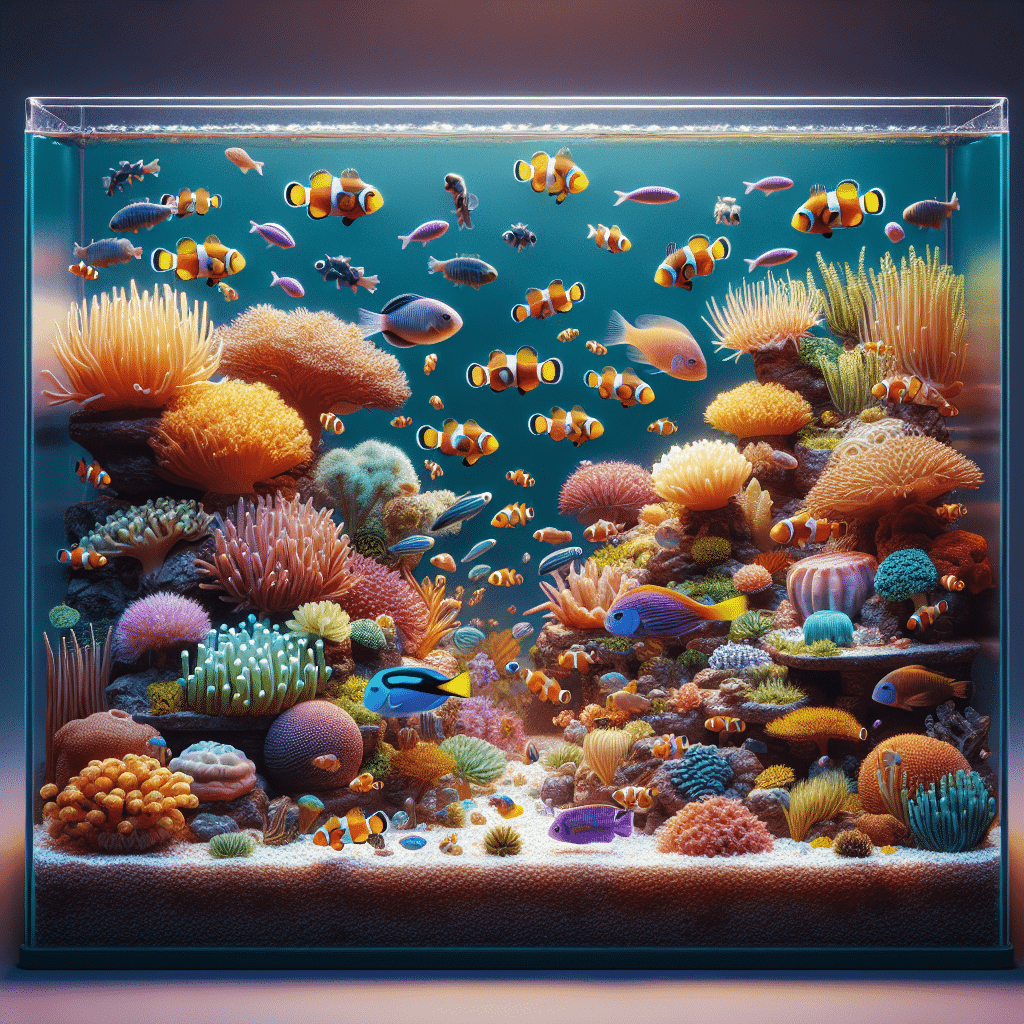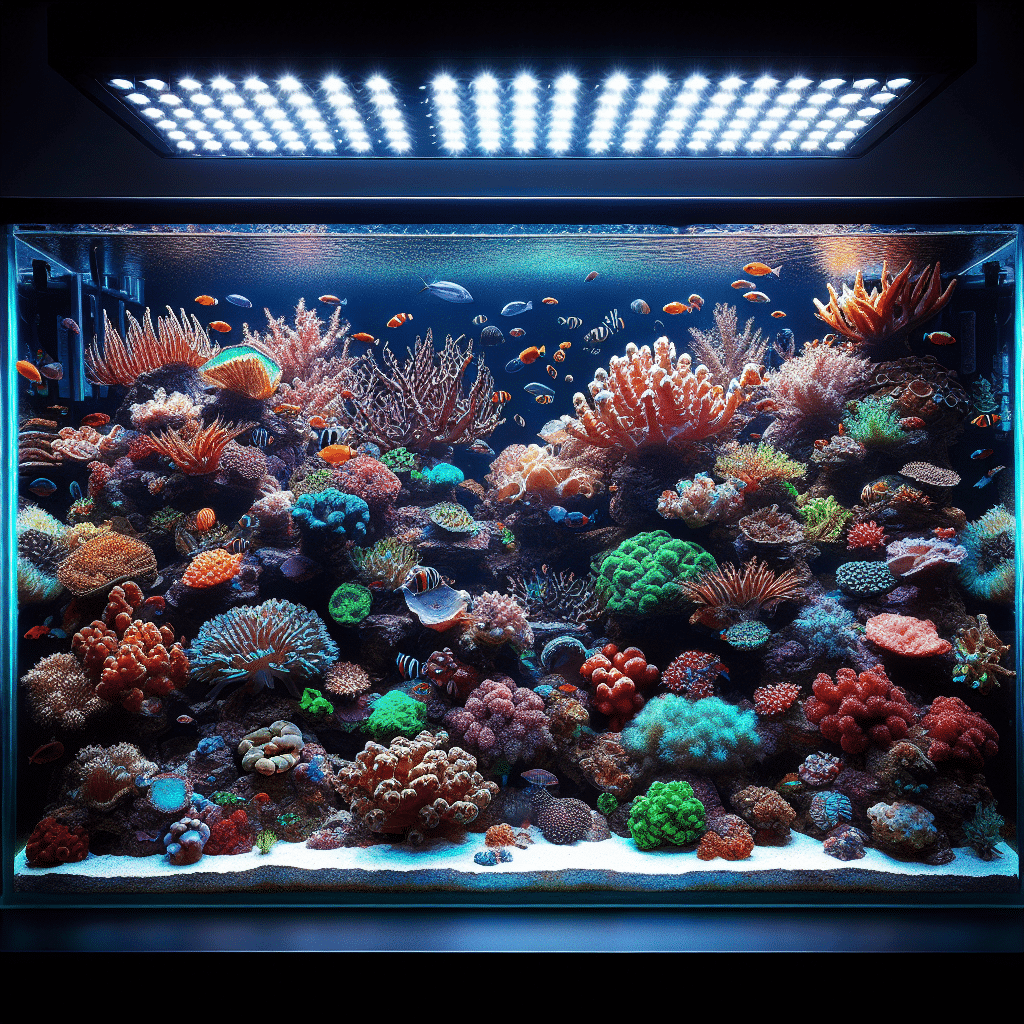Understanding Nano Reef Tank Filtration
Effective filtration is essential for maintaining a healthy environment in nano reef tanks. This section explores canister filters and the frequency of changing filter media, which are crucial components of nano reef tank filtration.
Canister Filters for Nano Tanks
Canister filters are a popular choice for nano reef tanks. They are designed to provide powerful filtration and can accommodate various types of filter media. Users have optimized their systems specifically for canister-driven filtration, allowing for better control of water quality and clarity.
One key advantage of canister filters is their ability to add carbon or other specialized filter media to the tank. This feature helps in removing impurities and enhancing water quality. However, it is important to maintain these filters regularly. If canister filters are not cleaned every 2-4 weeks, they can lead to the build-up of nitrates and phosphates due to trapped food or organic materials. This can adversely affect the health of the tank’s inhabitants.
| Filter Type | Advantages | Maintenance Frequency |
|---|---|---|
| Canister Filter | Powerful, customizable media options | Every 2-4 weeks |
| Hang on Back Filter | Easy installation, compact | Every 2-4 weeks |
Changing Filter Media Frequency
Changing filter media regularly is critical for ensuring optimal filtration in a nano reef tank. The frequency of changing the filter media can depend on several factors, including the tank’s bioload, the type of media used, and the overall water quality.
Mechanical filtration is one of the primary methods used to filter out suspended particles from the water. Various types of mechanical media—such as filter rollers, pads, sponges, and socks—can be employed. The effectiveness of these media is often measured in microns, with denser media capable of capturing finer particles, thereby contributing to clearer water.
For biological filtration, beneficial bacteria are crucial as they break down waste and leftover fish food. The biological filter media, like ceramic rings and bio-balls, provide the necessary surface area for these bacteria to thrive. Once established, this media can remain in the system as long as it stays wet and the bacteria is alive, thus reducing the need for frequent replacement.
It is advisable for tank owners to monitor their water parameters regularly and adjust the frequency of media changes based on the observed water quality and the specific needs of their nano reef ecosystem. For more information on the various types of equipment needed for setting up a nano reef tank, visit our guide on nano reef tank equipment.
Essential Components for Nano Reef Tanks
In a nano reef tank, certain components are essential for maintaining a healthy and thriving environment for marine life. Two of the most crucial elements are live rock and protein skimmers.
Live Rock in Reef Tanks
Live rock plays a vital role in nano reef tanks as it acts as a biological filter. It contains beneficial bacteria that help break down fish waste and other organic matter, ensuring a balanced ecosystem. It is generally recommended to use between 1 to 2 pounds of live rock per gallon of water in a reef tank. Proper curing of live rock is crucial before adding any livestock to avoid introducing harmful bacteria or pollutants into the tank.
| Live Rock Recommendation | Amount per Gallon |
|---|---|
| Minimum | 1 pound |
| Maximum | 2 pounds |
Importance of Protein Skimmers
Protein skimmers, also known as foam fractionators, are essential for maintaining water quality in reef tanks. They work by creating micro bubbles that attract dissolved organic pollutants, effectively removing them from the water. The result of this process is a collection of smelly, tea to coffee-colored liquid known as skimmate.
Protein skimmers are specifically designed for saltwater aquariums and utilize a process called “foam fractionization,” which is not effective in freshwater environments. By removing concentrated waste and promoting gas exchange, protein skimmers help keep the water oxygenated and healthy for marine life.
| Protein Skimmer Benefits | Description |
|---|---|
| Waste Removal | Eliminates organic pollutants from the water |
| Gas Exchange | Increases oxygen levels in the tank |
| Concentrated Waste Collection | Produces skimmate for easy disposal |
Incorporating these essential components into a nano reef tank setup is crucial for ensuring the health and vitality of the aquatic environment. For more information on creating a thriving aquarium, check our articles on best nano reef tank and nano reef tank setup.
Effective Filtration Systems
In the realm of nano reef tank filtration, selecting the right filtration system is critical for maintaining a healthy aquatic environment. This section explores the differences between canister and hang-on-back filters, the role of refugiums in nutrient export, and the advantages of wet/dry filters for reef tanks.
Canister vs. Hang on Back Filters
Canister filters and Hang on Back (HOB) filters are popular choices for reef tanks. Both types of filters excel at adding carbon or other filter media to the water. However, they require regular maintenance to function effectively. If not cleaned every 2-4 weeks, they can accumulate nitrates and phosphates due to trapped food particles and organics. Neglecting maintenance may result in water bypassing the filter media, reducing filtration efficiency.
| Filter Type | Advantages | Disadvantages |
|---|---|---|
| Canister Filter | Excellent media versatility, customizable | Requires regular cleaning, can be bulky |
| HOB Filter | Easy to install, compact design | Limited media options, may require frequent replacements |
Role of Refugiums in Nutrient Export
Refugiums serve as an effective method for nutrient export in reef tanks, particularly for phosphate and nitrates. They provide a safe haven for beneficial microorganisms like amphipods and copepods, which can contribute to the diet of fish and corals. Additionally, refugiums can help stabilize the pH in the aquarium by utilizing the carbon dioxide produced in the main tank when the lights are off.
| Benefit | Description |
|---|---|
| Nutrient Export | Reduces phosphates and nitrates effectively |
| Biodiversity | Supports beneficial microorganisms |
| pH Stabilization | Utilizes CO2 to maintain pH levels |
Wet/Dry Filters for Reef Tanks
Wet/dry filters are known for their efficiency in converting toxic ammonia into less harmful nitrate in reef tanks. These filters create an aerobic environment for bacteria that break down waste, all while preserving oxygen levels in the main tank. However, they can sometimes be too efficient, leading to a rapid accumulation of nitrate levels (Nano-Reef.com).
| Filter Type | Efficiency | Considerations |
|---|---|---|
| Wet/Dry Filter | Highly efficient in ammonia removal | Can lead to quick nitrate buildup |
Understanding these filtration systems is crucial for anyone interested in the setup and maintenance of a successful nano reef tank. For further information, readers can explore topics such as nano reef tank setup and nano reef tank maintenance.
Advanced Filtration Techniques
Effective filtration is crucial for maintaining a healthy environment in a nano reef tank. Advanced filtration techniques can provide added benefits in terms of water quality and overall tank stability. Here, we explore two significant methods: utilizing sumps in saltwater tanks and algal filtration methods.
Utilizing Sumps in Saltwater Tanks
Sumps are increasingly popular in saltwater aquariums, including nano reef tanks. They offer several advantages over traditional filtration methods. Sumps create additional space for more complex filtration equipment and can hide equipment out of view, improving aesthetics. They are also easier to access for maintenance and increase the overall system water volume, which contributes to better stability in the aquarium environment.
Here are some of the key benefits of using a sump:
| Benefit | Description |
|---|---|
| Increased Water Volume | Enhances stability and dilute pollutants. |
| Additional Filtration Options | Space for protein skimmers and other filtration devices. |
| Improved Aesthetics | Hides equipment from view, keeping the display tank clean. |
| Easier Maintenance | Simplifies access to equipment and water changes. |
Algal Filtration Methods
Algal filtration techniques, such as refugiums, scrubbers, and reactors, are specifically designed for marine aquariums. These methods leverage algae to export nutrients and help control algae growth in the tank. By allowing easy harvesting of algae, these systems facilitate the removal of excess nutrients, contributing to the overall health of the reef ecosystem. Algal filtration also helps maintain stable pH levels and is relatively low-maintenance (Bulk Reef Supply).
| Algal Filtration Method | Description |
|---|---|
| Refugiums | Separate compartments that cultivate algae and beneficial organisms. |
| Algal Scrubbers | Systems that promote algae growth on a screen for nutrient export. |
| Algal Reactors | Enclosed systems that allow for controlled algae growth and harvesting. |
By incorporating advanced filtration techniques like sumps and algal methods, hobbyists can significantly improve the water quality and stability of their nano reef tanks. These methods not only support the health of fish and corals but also enhance the overall aesthetic and functionality of the aquarium. For additional guidance on setting up a successful nano reef tank, consider exploring our articles on nano reef tank setup and nano reef tank maintenance.
Tailoring Filtration to Specific Needs
Understanding how to customize filtration for a nano reef tank is essential for maintaining a healthy aquatic environment. Filtration systems can evolve and adapt to meet the specific demands of the tank’s inhabitants, from fish to corals.
Evolution of Filtration Systems
The filtration system for a saltwater tank can evolve over time based on specific goals and livestock desires. A simple fish-only saltwater aquarium can be maintained with basic equipment like a glass box, heater, and power hang-on filter. However, a marine reef aquarium necessitates more complex gear tailored to corals and invertebrates.
As hobbyists become more experienced, they often add advanced components to their filtration systems, such as protein skimmers, refugiums, and specialized filter media. This evolution is crucial for managing waste and maintaining water quality, especially in a nano reef tank where space is limited.
| Filtration System Type | Complexity Level | Suitable For |
|---|---|---|
| Basic Hang-on Filters | Low | Fish-only tanks |
| Canister Filters | Medium | Small reef setups |
| Sumps and Refugiums | High | Advanced reef tanks |
Transitioning from Freshwater to Saltwater Filtration
Transitioning from a freshwater to a saltwater aquarium can be an exciting but challenging process. Common filtration systems like submersible, canister, and power hang-on filters used in freshwater tanks can work well in basic saltwater aquariums. It is crucial to clean the equipment thoroughly and use new media for the saltwater tank to avoid any contamination (Bulk Reef Supply).
Saltwater systems typically require additional components to maintain stable parameters that are vital for the health of marine life. For example, incorporating a protein skimmer can help remove organic waste before it breaks down into harmful compounds. Understanding the differences in filtration needs will help in the successful setup of a nano reef tank.
| Filtration Type | Freshwater Compatibility | Saltwater Compatibility |
|---|---|---|
| Submersible Filters | Yes | Yes (basic) |
| Canister Filters | Yes | Yes (with upgrades) |
| Power Hang-on Filters | Yes | Yes (with modifications) |
| Protein Skimmers | No | Yes |
Tailoring filtration systems to specific needs ensures that the aquatic environment is healthy and sustainable. Knowledge about the evolution of filtration systems and the transition from freshwater to saltwater is essential for anyone looking to establish a thriving nano reef tank.
Dive into Filter Media
Understanding the different types of filter media is essential for effective nano reef tank filtration. Each type serves a unique purpose in maintaining water quality and supporting the health of the aquarium’s inhabitants.
Mechanical Filtration Basics
Mechanical filtration is the process of physically removing suspended or undissolved particles from the water. Various types of mechanical media can be utilized, including filter rollers, pads, sponges, and socks. The effectiveness of mechanical filtration is measured in microns, with denser media capturing finer particles, while more porous media allows for better water flow but captures larger debris. For optimal performance, it is crucial to regularly clean or replace mechanical filter media to prevent clogging and maintain clear water (Bulk Reef Supply).
| Type of Media | Particle Size Captured (Microns) |
|---|---|
| Filter Rollers | 5-10 |
| Filter Pads | 1-5 |
| Sponges | 10-100 |
| Filter Socks | 5-100 |
The Power of Activated Carbon
Activated carbon is a widely used option in chemical filtration systems, effectively removing impurities from the water. It helps to clear yellow discoloration, eliminate odors, and remove chemical toxins released by corals, medications, and other contaminants. Granular activated carbon is commonly recommended, and it should ideally be replaced every 5-7 days in saltwater tanks to maintain its efficiency (Bulk Reef Supply).
GFO and Phosphate Removal
Granular Ferric Oxide (GFO) is specifically designed to remove phosphate from aquarium water, which is a primary contributor to nuisance algae growth. GFO works by binding to phosphate molecules in the water, effectively reducing their concentration. It is essential to use GFO as a solution to address existing phosphate problems rather than as a preventative measure. For optimal performance, GFO should be utilized in a fluidized media reactor (Bulk Reef Supply).
Resin Media for Chemical Filtration
Resin media, such as Seachem Purigen and Blue Life OrganicRx, targets a variety of contaminants, including heavy metals, phosphates, and dissolved organic compounds. One significant advantage of resin media is its ability to be recharged and reused multiple times, offering a sustainable option for chemical filtration. It can also be combined with activated carbon and GFO to create a comprehensive All-In-One Media for enhanced filtration (Bulk Reef Supply).
Beneficial Bacteria in Biological Filtration
Beneficial bacteria are vital for biological filtration within a nano reef tank. They break down organic waste and leftover food, helping to maintain water quality. Biological filter media, such as ceramic rings, bio-blocks, and bio-balls, provide additional surface area for these bacteria to thrive. Once established, bio-media supports the aquarium’s biological stability and does not require replacement as long as it remains moist and the bacteria are alive.
By understanding these various types of filter media, aquarium enthusiasts can make informed decisions that enhance the health and beauty of their nano reef tanks. For more information on choosing the right setup, explore our articles on nano reef tank setup and nano reef tank maintenance.



